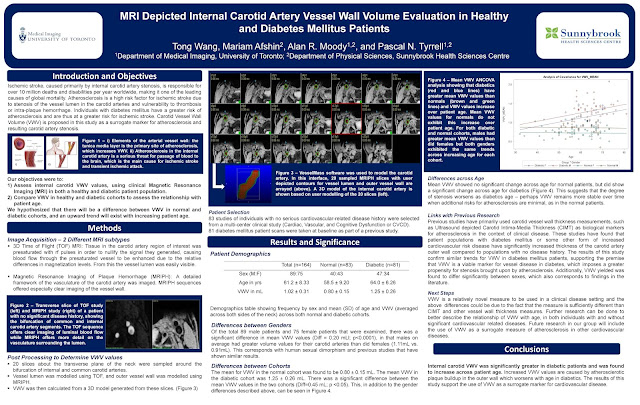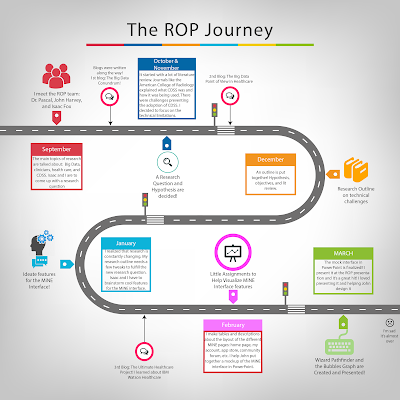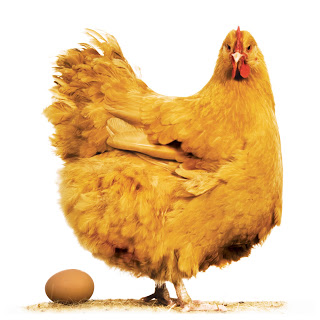 |
| GeorgeWang – ROP299Y 2016-17 |
Engaging Primary Care in Research: Not Always an Easy Task
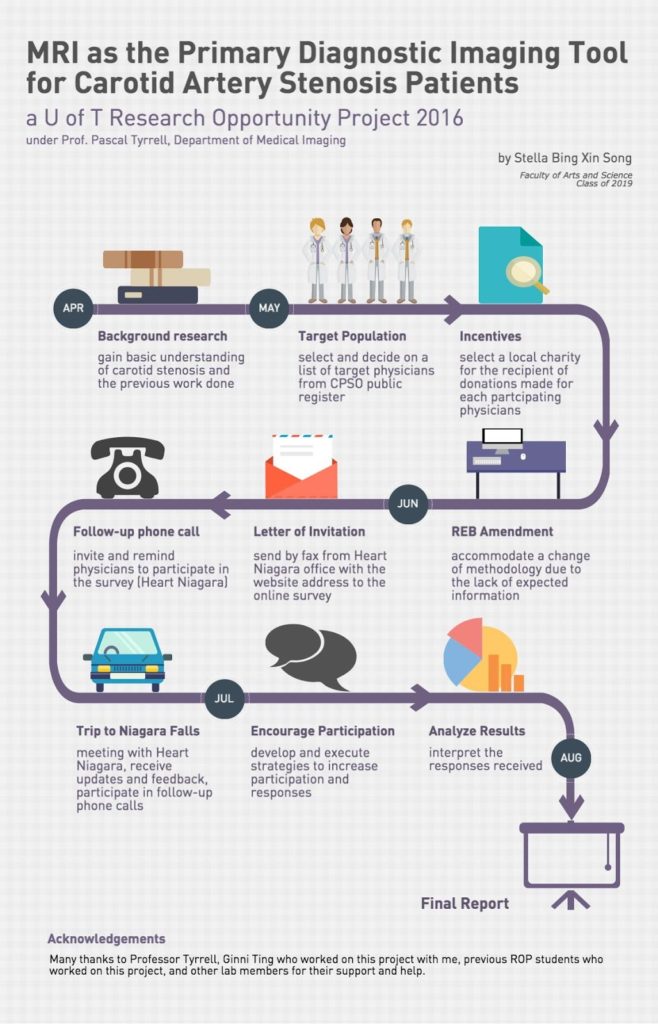
I am Stella Bing Xin Song, currently a second year student studying pharmacology and psychology at University of Toronto. I was fortunate to be a part of the 2016 Research Opportunity Program (ROP) supervised by Dr. Pascal Tyrrell in the Department of Medical Imaging at University of Toronto.
My ROP project focused on evaluating the feasibility of using MRI as the primary imaging modality for carotid artery stenosis diagnosis and assessment (not sure what we are talking about? See previous posts here and here). Along with Ginni Ting, a student volunteer in Dr. Tyrrell’s lab, we surveyed physicians in the Niagara region of Ontario to learn about their perspectives on this proposal. Our community partner in this research was Heart Niagara – a fantastic local organization that has been guiding advances in cardiac health education and services since 1977.
Most of the responding physicians saw approximately 2000 or more patients per year. Physicians expressed a variety of care-related decisions for carotid artery stenosis patients, especially for those where diagnosis was less obvious with less than 70% stenosis. Most responding physicians would consider MRI over Ultrasound as the first-line diagnostic imaging modality, because of its ability to detect IPH yielding more pertinent information. IPH is bleeding within the plaques, which causes them to become more vulnerable (see vulnerable plaque). There is a 6 times greater risk of stroke in people with IPH! For those who were reluctant to consider it, they expressed that it was mostly due to their concerns for the relative cost and current wait time for MRI.
Unfortunately, the response rate for this online survey was very low. Reasons given for the reluctance to participate were that physicians were on a tight schedule and were busy with their patients. Feedback from participants was that the online survey seemed long. Nevertheless, from the responses received, we were able to learn more about physicians’ perspectives of using MRI for carotid artery stenosis diagnosis and assessment.
In the end, it was an exciting and valuable experience to plan out and execute this research project. Most importantly, I had the pleasure to join Dr. Tyrrell’s lab and meet his team. I am grateful for all the help and support which I have received throughout my time at the lab. I look forward to continuing to work as a member of Dr. Tyrrell’s lab.
Stella Bing
U of T Research Opportunity Program – Clare Sheen
Clare Sheen is an undergraduate student at the University of Toronto, in process of completing her Bachelor of Sciences in Genomics and Microbiology/Molecular Genetics. She was a 2015-6 Research Opportunity Program (ROP) student working on designing the Medical Image Network Enterprise (MiNE) interface for Dr. Pascal Tyrrell from U of T’s Department of Medical Imaging. She is currently a social director on the Life Science Student Network exec team and a volunteer at U of T’s Agrawal Lab where she helps with Drosophila experiments. She continues to seasonally work as a student camp teacher in the summer.
At the Research Opportunity Program (ROP) fair on March 3rd, U of T ROP students from different departments came together to share their research. A mock-up of the MiNE interface was presented in PowerPoint with the goal of increasing user engagement and encouraging the development of a medical imaging research community. Some features of the interface are presented below.
Back to Basics… Midpoint Thoughts from an ROP Student
Through the ‘Research Opportunity Program‘ (ROP) for second year students at U of T, I have been working on a project about physicians’ willingness to use MRI as the front-line diagnostic imaging technology for carotid stenosis patients. For a description see here.
After a recent discussion with Dr. Tyrrell (my supervisor), and as I approach the midpoint of my ROP project, I thought it would be a good idea to review some of my background knowledge of carotid stenosis from my work in the Fall term. Having a certain amount of independence while working on this project has been a great experience, but it also means I am responsible for keeping track of my own learning.
Begrudgingly, I’ll admit that this ‘self-directed’ review process has shed new light on the usefulness of midterms in other courses. However, I still prefer this project-based review format. It has allowed me to review necessary information to make sure that it is fresh in my mind. Now I feel more prepared to begin the second half of the project. I’m looking forward to a major meeting this month and all the other exciting parts of the project to come.
Julia Robson
Kiersten Thomas – Summer 2015 ROP at UofT: Another great student experience… part deux!
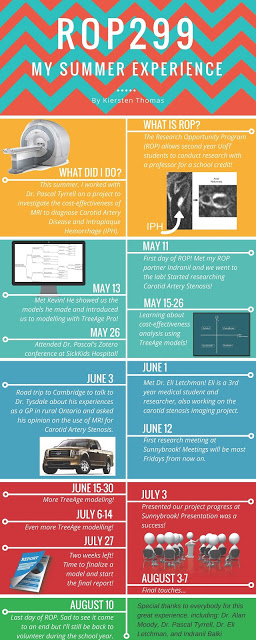 |
| Kiersten Thomas – ROP summer 2015 |
Hello, I’m one of Professor Pascal Tyrrell’s summer ROP students and a second year Immunology Specialist student at the University of Toronto. I have just completed my summer research project investigating the cost-effectiveness of using MRA to evaluate asymptomatic carotid artery stenosis.
I learned a lot and had an amazing time conducting research with Dr. Eli Lechtman and my ROP partner Indranil Balki. Using TreeAge Pro to create and analyse decision trees, we demonstrated that the additional information gained from an MRA/IPH scan increases the effectiveness of MRA when imaging carotid artery stenosis.
Our research suggests that the additional information of the presence of intraplaque hemorrhage (IPH) would lead to better patient care, reducing long-term stroke risks. This means that MRA/IPH can be cost-effective or even dominant when compared to the current imaging strategy that uses standard ultrasound as a first-line imaging modality, for evaluating all degrees of asymptomatic carotid artery stenosis. Take a look at my timeline to see some of the highlights of my summer!
Thank you Dr. Pascal for this wonderful summer.
Kiersten Thomas
Indranil Balki – Summer 2015 ROP at UofT: Another great student experience!
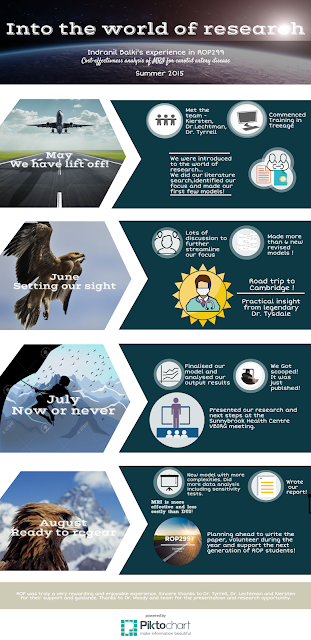 |
| Indranil Balki – ROP Summer 2015 |
Thanks to Dr. Pascal for allowing me to share my experience on his blog and I hope you enjoy the read!
An “Egg-cellent” Journey to Investigate Carotid Artery Stenosis in Cambridge, Ontario…
Last Wednesday, my ROP students Kiersten and Indranil, and UofT medical student Eli Lechtman had the opportunity to interview the legendary (see here) Dr. Kim Tysdale – a general practitioner in Cambridge, Ontario.
Why do you ask? Well each year 50,000 Canadians suffer from a stroke with 26% due to carotid artery disease. Carotid artery stenosis is the narrowing of the carotid arteries due to plaque buildup (see atherosclerosis). These plaques can then rupture and create blood clots that travel up to the brain. In turn, these blood clots then get stuck in the brain’s smaller blood vessels, causing a stroke. So plaque = bad and ruptured plaque = worse!
What if we had a clue as to which plaque may rupture? Well, in turns out that the presence of intraplaque hemorrhage (IPH) can help us predict just that! IPH is bleeding within the plaques, which causes them to become more vulnerable (see vulnerable plaque). There is a 6 times greater risk of stroke in people with IPH! And…. a new medical imaging technique called MRIPH imaging allows for visualization of IPH. MRIPH is similar to traditional MRI but highlights the artery walls and looks at the arterial plaques.
While in Cambridge, Kiersten, Indranil, and Eli presented Dr. Tysdale with an overview of medical imaging techniques for the assessment of carotid artery stenosis with an emphasis on the new MRIPH technique. Informing physicians like Dr. Tysdale which of his patients are more at risk of having vulnerable plaques (by providing information on IPH) could result in patients receiving more appropriate and timely treatment – thereby reducing the number of strokes!
BTW, we had Dr Tysdale at “hello” (not sure what I am referring to? See here).
So what up with the eggs? Kiersten, Indranil, and Eli also had the chance to tour Dr. Tysdale’s beautiful country house and meet his lovely wife (and nurse!), Eva, who sent everyone home with fresh chicken eggs! Awesome.
Thank you Dr Tysdale for being such a great sport!
Here is their infographic of the trip (great job gang!). Enjoy!
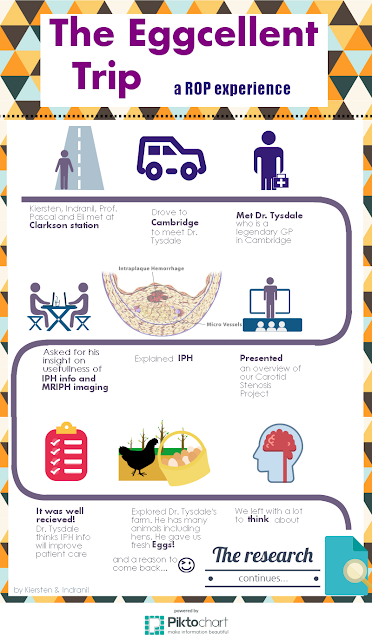 |
| Kiersten Thomas and Indranil Balki – ROP Summer 2015 |
Stay tuned for more ROP adventures!
Pascal Tyrrell
Research Opportunity Program: Imaging Carotid Stenosis
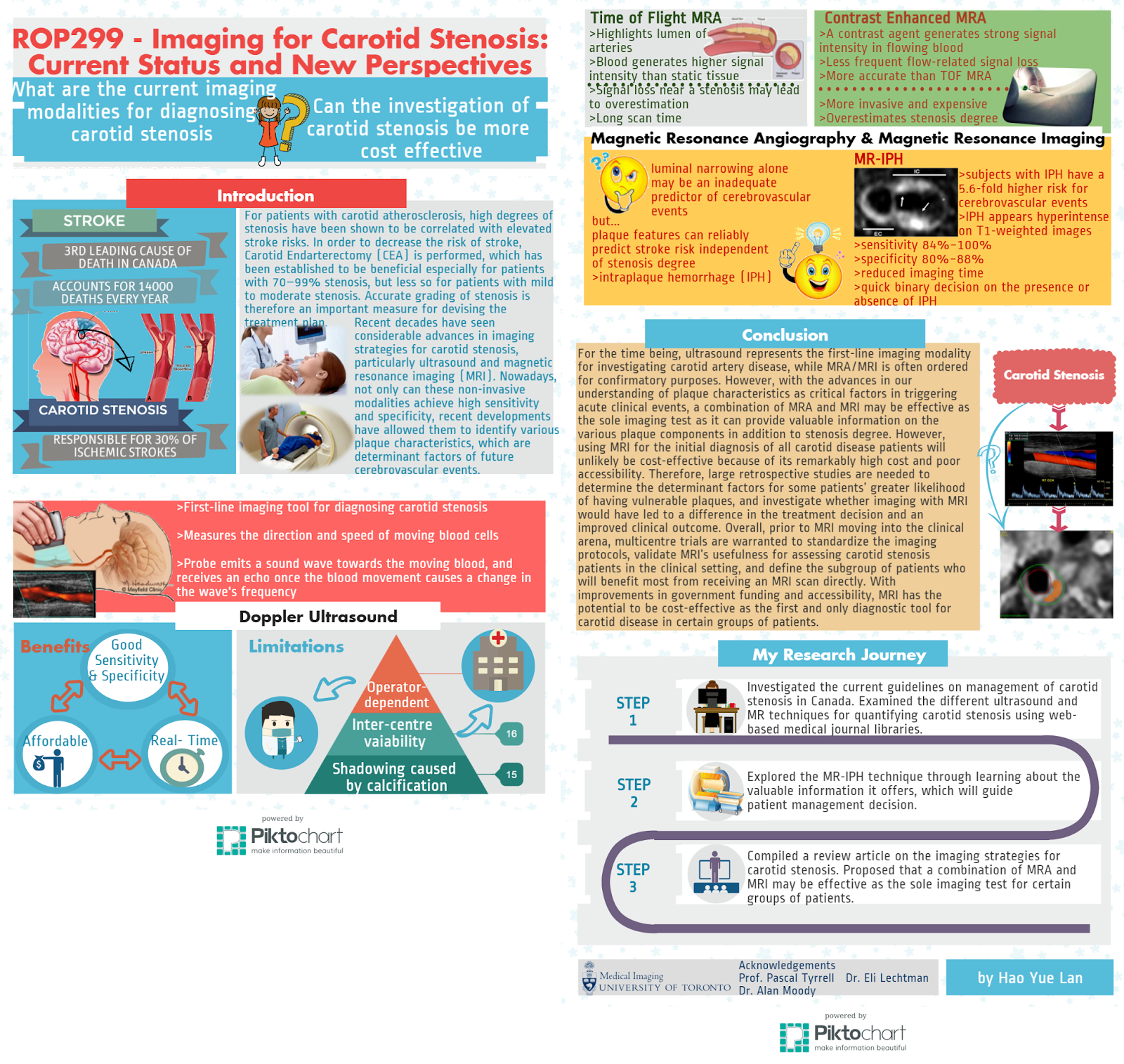 |
| ROP Research Forum March 5th, 2015 – Helena Lan |
Helena is a second-year student pursuing a specialist in Pharmacology and Toxicology at the University of Toronto. Participating in ROP299 this past summer (see here) has opened many doors for her. She is currently assisting Pascal on a systematic review on research methodology and biostatistics in medical imaging, working as a research assistant for a medical education study, participating in the research abroad program at Karolinska Institutet this summer… and recently represented us at the March 5th, 2015 ROP research forum!
Helena examined the technical aspects and information provided by two major imaging modalities, MRI and ultrasound, for diagnosing carotid stenosis. She suggests that MRI holds great promise to serve as a cost effective test for carotid stenosis as well as a tool for assessing vessel health and plaque composition that would provide important information for patient management decisions.
Stay tuned, next Sylvia Urbanik will be talking about cost effectiveness…
See you in the blogosphere,
Pascal Tyrrell
Research Opportunity Program: What Is Carotid Stenosis and How Are We Treating Affected Patients?
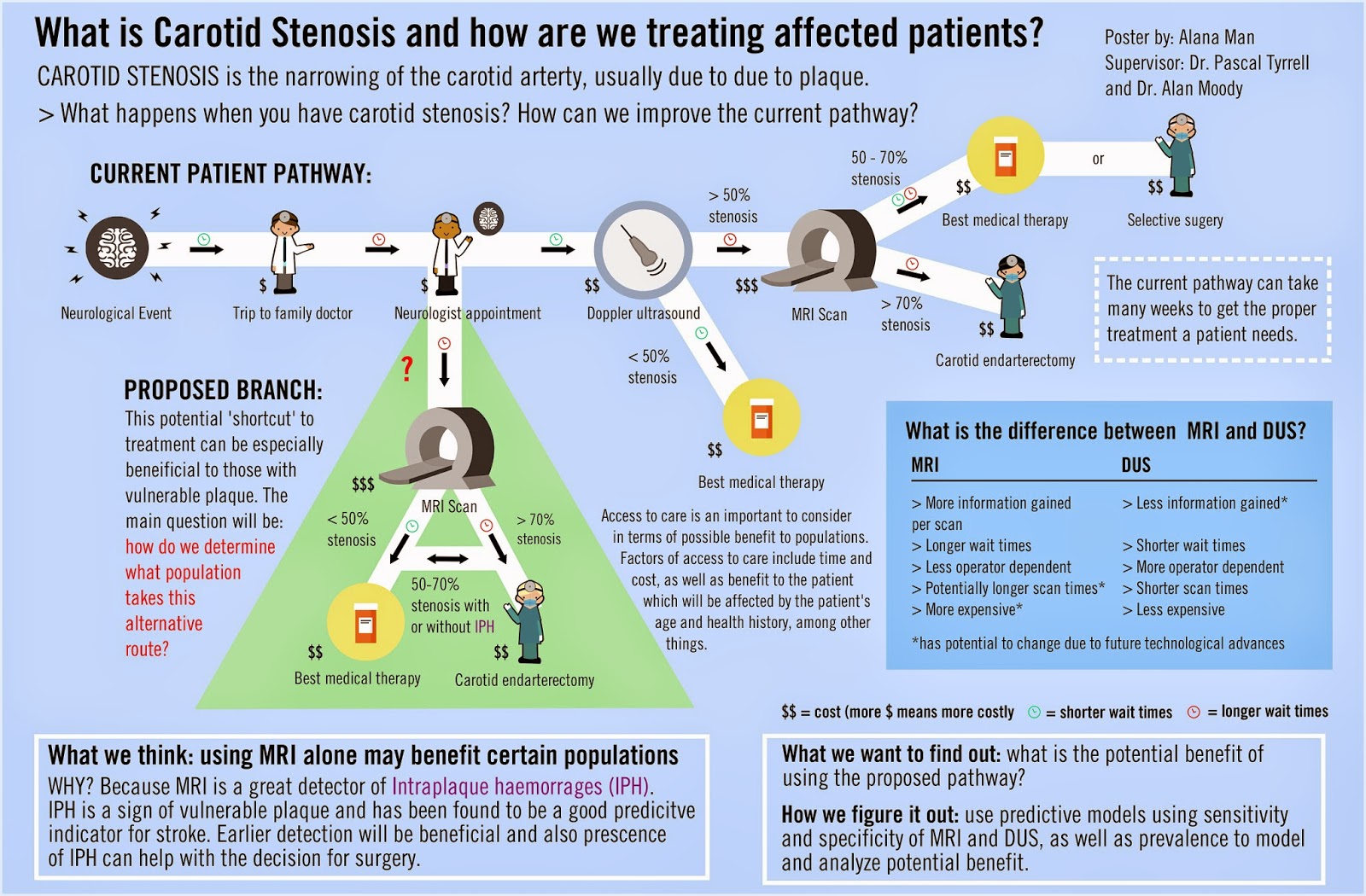 |
| ROP Research Forum March 5th, 2015 – Alana Man |
Alana Man is a second year University of Toronto student pursuing a specialist in Bioinformatics and Computational Biology and a major in Immunology. She was a Research Opportunity student last summer with MiVIP (see here) and recently represented us at the March 5th, 2015 ROP research forum.
Alana’s project focused on care for patients with carotid stenosis in Toronto, Ontario, Canada. She looked at the different factors contributing to access to diagnostic testing such as procedure costs, wait times, and the differences between available imaging modalities and explores whether MRI could be the diagnostic test of choice over DUS for people at increased risk of carotid stenosis.
Well done, Alana!
Stay tuned, next Helena Lan will be comparing MRI and DUS…
See you in the blogosphere,
Pascal Tyrrell
Helena Lan: Summer 2014 ROP
 |
| Helena Lan Summer 2014 ROP |
What is research like? If you had asked me this
question several months ago, I would have answered, “You wear a lab coat and
goggles while mixing chemicals or observing organisms. Hopefully something
interesting will happen, so that you get to publish your findings!” Well, after
participating in the Research Opportunity Program (ROP) at the University of
Toronto, I discovered that medical imaging research is more than just
pipetting, and is all the more exciting!
way. Also, I’m very grateful to Dr. Alan Moody for including us in his research program at Sunnybrook, as well as other members of the VBIRG group who gave us the chance to
participate in various activities. My summer would not have been this fun and meaningful without all of your help!
Helena Lan

